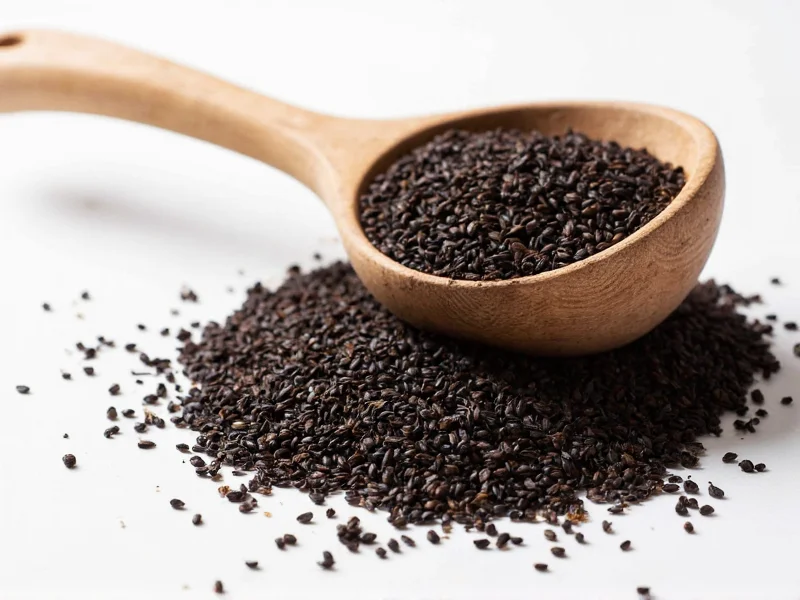Nigella seeds have been valued for thousands of years, with historical evidence of their use dating back to ancient Egyptian times. Archaeologists discovered nigella seeds in Tutankhamun's tomb, suggesting their importance in early civilizations. The plant itself is an annual flowering herb that grows to about 20-30 cm in height, producing delicate pale purple or white flowers.
Botanical Classification and Characteristics
Nigella sativa belongs to the buttercup family (Ranunculaceae) and should not be confused with true cumin (Cuminum cyminum) despite the "black cumin" nickname. Each seed measures approximately 2-3 mm in length, with a matte black color and a distinctive curved, triangular shape. When crushed, they release a complex aroma reminiscent of oregano with subtle peppery and nutty notes.
| Characteristic | Description |
|---|---|
| Scientific Name | Nigella sativa |
| Common Names | Kalonji, black cumin, black seed, fennel flower |
| Flavor Profile | Slightly bitter, peppery with onion-like notes |
| Appearance | Small (2-3mm), matte black, angular seeds |
| Primary Growing Regions | Eastern Europe, Middle East, India, North Africa |
Cultural Significance and Historical Use
The historical significance of nigella seeds extends across multiple ancient civilizations. In traditional Ayurvedic medicine, kalonji has been used for centuries to support respiratory health and digestion. Islamic tradition references nigella seeds in hadiths, with some texts suggesting they contain 'a cure for all diseases except death.' Ancient Greek physicians like Dioscorides documented their medicinal properties, while Roman cooks incorporated them into various recipes.
Culinary Applications Worldwide
Understanding what nigella seeds are used for reveals their versatility across global cuisines. In Indian cooking, kalonji is a fundamental component of panch phoron (a five-spice blend) and frequently appears in naan bread, pickles, and lentil dishes. Middle Eastern bakers sprinkle them on flatbreads like naan and lavash, while Turkish cuisine features them in simit (sesame-encrusted rings). Chefs exploring how to use nigella seeds in cooking often toast them lightly to enhance their complex flavor before adding to curries, vegetable dishes, or salad dressings.
When comparing nigella seeds vs black sesame, the differences become apparent. While both are small black seeds, nigella has a more pronounced bitter note and distinctive triangular shape, whereas black sesame offers a nuttier, sweeter profile. Confusing these seeds can significantly alter a dish's intended flavor profile.
Nutritional Profile and Research Insights
Regarding kalonji seeds nutritional value, they contain thymoquinone (the primary active compound), along with fiber, healthy fats, and various minerals including iron, calcium, and potassium. Current scientific research is examining potential health benefits of nigella seeds, though it's important to note that most studies have been conducted in laboratory settings or with small human trials. Researchers are investigating their antioxidant properties and potential effects on inflammatory responses.
When discussing nigella sativa seed benefits, it's crucial to maintain scientific accuracy. While traditional medicine systems have used these seeds for various purposes, modern science requires more comprehensive human studies before making definitive health claims. Consumers interested in nigella seeds health benefits should view them as a flavorful culinary ingredient rather than a medicinal supplement.
Practical Usage and Storage
For optimal flavor, store nigella seeds in an airtight container away from light and heat. Properly stored, they maintain their potency for 1-2 years. Many home cooks wonder where to buy nigella seeds—they're increasingly available in well-stocked grocery stores, international markets (particularly Indian or Middle Eastern), and reputable online spice retailers.
When incorporating nigella seeds into recipes, remember they have a strong flavor that intensifies when heated. Start with small amounts (1/4 to 1/2 teaspoon per dish) to avoid overwhelming other ingredients. They pair particularly well with yogurt-based sauces, roasted vegetables, and hearty grain dishes.
Safety Considerations
Nigella seeds are generally recognized as safe when consumed in culinary amounts. However, individuals with seed allergies should exercise caution. Pregnant women should consult healthcare providers before consuming nigella seeds in medicinal quantities, as some compounds may affect uterine activity. As with any food ingredient, moderation is key—excessive consumption may cause digestive discomfort.
Common Substitutes
When nigella seeds aren't available, several alternatives can approximate their flavor profile. Onion seeds (nigella's frequent misnomer) actually refer to nigella themselves, so this common search term often confuses shoppers. Black sesame seeds provide visual similarity but lack the distinctive bitter notes. A combination of cumin and poppy seeds can mimic some aspects of nigella's flavor in a pinch, though the result won't be identical.











 浙公网安备
33010002000092号
浙公网安备
33010002000092号 浙B2-20120091-4
浙B2-20120091-4